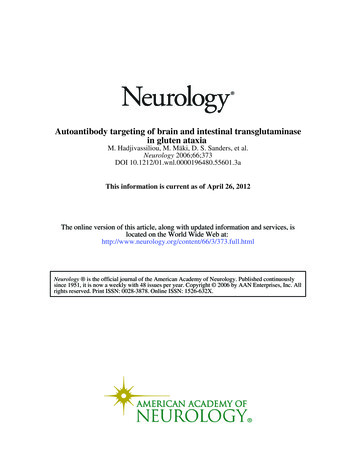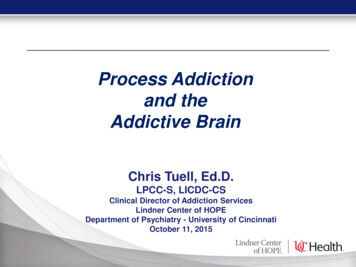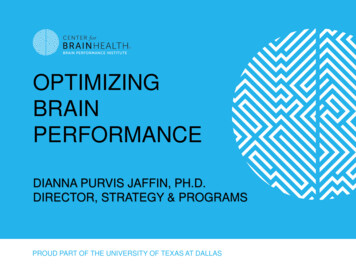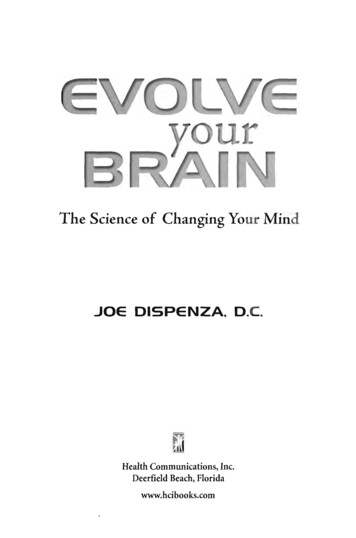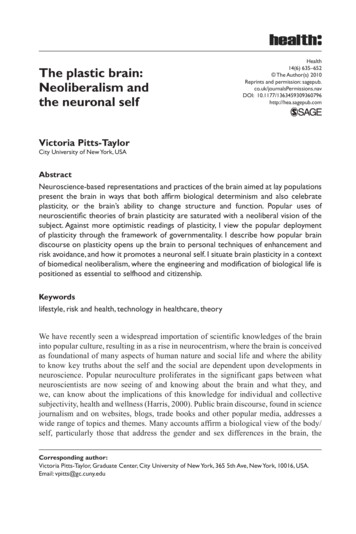
Transcription
The plastic brain:Neoliberalism andthe neuronal selfHealth14(6) 635–652 The Author(s) 2010Reprints and permission: sagepub.co.uk/journalsPermissions.navDOI: oria Pitts-TaylorCity University of New York, USAAbstractNeuroscience-based representations and practices of the brain aimed at lay populationspresent the brain in ways that both affirm biological determinism and also celebrateplasticity, or the brain’s ability to change structure and function. Popular uses ofneuroscientific theories of brain plasticity are saturated with a neoliberal vision of thesubject. Against more optimistic readings of plasticity, I view the popular deploymentof plasticity through the framework of governmentality. I describe how popular braindiscourse on plasticity opens up the brain to personal techniques of enhancement andrisk avoidance, and how it promotes a neuronal self. I situate brain plasticity in a contextof biomedical neoliberalism, where the engineering and modification of biological life ispositioned as essential to selfhood and citizenship.Keywordslifestyle, risk and health, technology in healthcare, theoryWe have recently seen a widespread importation of scientific knowledges of the braininto popular culture, resulting in as a rise in neurocentrism, where the brain is conceivedas foundational of many aspects of human nature and social life and where the abilityto know key truths about the self and the social are dependent upon developments inneuroscience. Popular neuroculture proliferates in the significant gaps between whatneuroscientists are now seeing of and knowing about the brain and what they, andwe, can know about the implications of this knowledge for individual and collectivesubjectivity, health and wellness (Harris, 2000). Public brain discourse, found in sciencejournalism and on websites, blogs, trade books and other popular media, addresses awide range of topics and themes. Many accounts affirm a biological view of the body/self, particularly those that address the gender and sex differences in the brain, theCorresponding author:Victoria Pitts-Taylor, Graduate Center, City University of New York, 365 5th Ave, New York, 10016, USA.Email: vpitts@gc.cuny.edu
636Health 14(6)biological roots of various kinds of mental illnesses, and the diagnostic possibilitiesof new technologies of visualizing the brain (PET and fMRI). For example, there is agreat deal of discussion in neuropsychology and in the media about brain ‘types’ anddifferences in brain anatomy and function among various categories of people, includingmen and women, and the case is being made for the biological basis of a wide rangeof behaviors and social problems once thought to be moral or psychological matters.In the law, neuroscientific knowledge is being presented as a challenge to notions offree will and personal responsibility (Dumit, 2004), and biologized notions of moralityare being offered through the use of fMRI in courtroom settings (Littlefield, 2009). Inevolutionary psychology the brain has been marshaled to support conservative ideasabout social roles (Machamer and Sytsma, 2004). Anne Beaulieu (2003: 563) notes thatnew mapping techniques of the brain are being used to reconfigure the nature/nurturedebate, such that complex ideas like culture can be translated into biological reactions inthe brain: ‘It is not only nature that counts; nurture also counts, but only once translatedinto a measurable activation in the brain.’ For critics, much of this discourse raises theprospect of biological determinism.However, there is also much public excitement about brain plasticity. Brainplasticity or neuroplasticity refers to the capacity of the brain to modify itself inresponse to changes in its functioning or environment. The basic concept of brainplasticity has existed for decades; in fact, as early as 1895 Ramon y Cajal was likelyto have proposed the ‘use – disuse’ hypothesis, which posed that ‘the initial [synaptic]connections present in infancy are modified by exercise throughout life’ (Rutledge,1976: 329). The mid-20th century saw much development on the concept, but plasticitydid not emerge as a primary way of thinking about the brain until the late 1970s and1980s. While once thought to be restricted primarily to early in the lifecycle and tocertain parts of the brain, neuroscientists now generally agree that plasticity appliesto the whole brain and to later in life as well (Mountcastle, 1998). Plasticity refersto multiple processes of brain function and structure. The brain can make new cells(neurogenesis) and new synaptic connections between neurons (synaptogenesis),and see established connections strengthened and weakened (synaptic modulation).Changes in neuronal connection can range from short to long term, and can be relatedto shifts in the density and length of dendrites (the receiving part of the neuron), ‘axonalsprouting’ (the expansion of nerve endings responsible for electrical output), increasesin synaptic activity, and metabolic changes, among other factors (Kolb and Wishaw,1998). Plasticity has been correlated not only with early learning, but also with shiftsin stress levels and hormones, with recovery from trauma and injury, and with learningnew skills in adolescence and adulthood.Understanding how plasticity works is conceived in neuroscientific circles as havingsignificant clinical potential, such as for reversing the effects of various neurodegenerativediseases and traumas of the brain. But for many, mastering knowledge of neuroplasticityis understood to have broader implications as well. As Andy Clark (1998) points out, theplastic brain is a situated brain, culturally, biologically, and socially. Plasticity appearsto challenge biological reductionism by providing room for the environment in braindevelopment and functioning, thus opening up a bridge between the hard and socialsciences, and between views of the mind/self as natural and hard-wired and those of
Pitts-Taylor637it as nurtured and socially shaped (Cromby, 2004; Eisenberg, 1995; Machamer andSytsma, 2004). In addition, it historicizes individual brains, since each brain respondsto its environment and also to its own workings over the lifespan (Malabou, 2008;Mountcastle, 1998).Some scholars have also pointed to brain plasticity as a concept which could bemarshaled to lessen some of the more politically conservative implications of currentneuroscientific thought, such as that various attributes of individuals and groups are hardwired in the brain. Elizabeth Wilson, for example, has described how the complexityof the neurological-psychological interface defies simplistic determinism. Contestingsome of the literature in feminist and constructionist psychology which has rejectedbrain-based explanations of psychic life (Cromby, 2004), she argues that ‘neurologicaldeterminism is most powerfully contested through neurological intimacy’ (Wilson, 1999:417), particularly intimacy with the details of how the brain – psyche – environmentinterface generates new brain structures and ontologies. Her reading of Peter Kramer’s(1997) popular book Listening to Prozac suggests that it complicates rather thanendorses biological determinism, because Kramer describes the brain as physiologicallychangeable, for example in response to psychic trauma.Rather than simply leading to or facilitating depression, neurological matter itself may becomeweakened, neurasthenic, depressive. Not simply the effect of extraneurological events, and notsimply the regulator of extraneurological events, this weakened and depressed neurologyinstantiates the literate, generative, and sometimes melancholic nature of biological matter ingeneral. (Wilson, 1999: 419)Here Wilson recasts the brain as a complex actor or agent, pointing to its dual capacityto respond to psychic experience and also to generate it. Rather than seeing the brainas a chemical source of depression or as a surface upon which psychic life can beinscribed, Wilson highlights its complexity and its positive or productive features.The key shift she makes here is to argue that foregrounding the brain as organ andbiological matter is compatible with complex and politically tenable interpretationsof psychic life.Other theorists celebrate plasticity as a biological condition for human agency,explicitly linking what Wilson sees as the ‘generative’ possibilities of the brain tocritical possibilities for embodied selfhood. They also affirm Wilson’s call for seeingneuroscientific knowledge as a resource for critical, rather than conservative, thought.Sean Watson (1998) sees contemporary neuroscience as vital for sociologists, whoseenthusiasm for social constructionism has led to a neglect of the material body, or the bodyas biological matter rather than a mere surface for cultural inscription (Newton, 2003;Radley, 1995; Williams, 2006). Contemporary neuroscience can provide explanationsregarding ‘how culture comes to inhabit a biological organism’ (Watson, 1998: 24).It can also provide details – material grounding – for theories which unsettle liberalnotions of stable subjectivity, such as Deleuze and Guattari’s notion of ‘becoming’.Watson (1998: 39) describes plasticity as the idea that ‘throughout the brain there isa fantastic multiplicity of spontaneously erupting experimental responses to outsideconditions, drive requirements and other stimuli’. For Watson, this means chaos, in
638Health 14(6)a politically fortunate sense, and creativity, as well as that the subject is decentered,unfixed. Parallels between Deleuzian theory and the neuroscience-based theories showthat we are ‘infinite multiplicities’:Where there is multiplicity there is an ‘exceptional individual’ or an ‘Outsider’. The ‘Outsider’ isanomalous as opposed to abnormal. The latter deviates from rules in a way which ensures he remainswithin the system. The anomalous is no longer inside, he is unintelligible. (Watson, 1998: 42)Brian Rotman (2000) also links plasticity to a multi-subjectivity, particularly in thecontext of high-tech life. Rotman sees the inner workings of our brains as incorporatingthe outside in ways that render everything in the environment part of our brain processing.Along with Andy Clark (1998), who calls everything we interact with ‘wideware’,Rotman (2000: 74) sees the outside as co-constituting the inside:all these artifacts, from windowed screens to hypertexts are rewiring the very brain/minds thatimagined them. In this way we are facilitating the emergence of a larger – collectivized, distributed, pluralized – ’intelligence’ by allowing ourselves to become more ‘othered,’ moreparallelist, more multi, less individualized – able to see, think, enjoy, feel and do more thanone thing at a time.The outcome of this for Rotman is a progressive postmodern subjectivity. Singularsubjects and truths, linear history, hegemonic dominance of singular ideas, are dying.Newly emergent is ‘the possibility of a new plurality of truths and futures: beings withan awareness of our/their multi-directional itinerary’ (Rotman, 2000: 77–78).Philosopher Catherine Malabou also sees progressive possibilities in plasticity. LikeWatson, plasticity indicates for Malabou the possibility of rebellion, of creativity, and ofnondeterminism. Plasticitydirectly contradicts rigidity. It is its exact antonym. In ordinary speech, it designates suppleness, a faculty for adaptation, the ability to evolve . to talk about the plasticity of the brainmeans – to see in it not only the creator and receiver of form but also an agency of disobedienceto every constituted form, a refusal to submit to a model. (Malabou, 2008: 5–6)Malabou sees ‘true plasticity’, however, as something that needs to be secured througha political consciousness. Unlike more poststructural and queer approaches, Malabou(2008: 8) claims the possibility of controlling our neuronal destiny – and perhaps ourbroader social and political life – through a neo-Marxist ‘neuronal liberation’, or apolitical consciousness of the implications of plasticity for the self and the social:securing a true plasticity of the brain means insisting on knowing what it can do and notsimply what it can tolerate. By the verb to do or to make we don’t mean just ‘doing’ math orpiano but making its history, becoming the subject of its history, grasping the connectionbetween the role of genetic nondeterminism at work in the construction of the brain and thepossibility of a social and political nondeterminism, in a word, a new freedom. (Malabou,2008: 13, emphasis in original)
Pitts-Taylor639These interpretations, to varying degrees, offer optimistic readings of plasticity,reflecting theorists’ preference for biological flux rather than fixity, and for historicity overstasis. Here plasticity is framed through postmodern, poststructural, queer, or progressiveunderstandings of subjectivity and social life. What is missing from these accounts,however, with the exception of Malabou, is an account of the power relations involved inseeing ourselves as neuronal subjects. A Foucauldian governmentality perspective suggestsreason for caution in celebrating plasticity as inherently liberating. My description here ofhow brain plasticity is taken up in popular neuroculture affirms the view that the use ofneuroscience does not inherently lead to determinism and can promote its opposite. But Ialso show here how brain plasticity positions neurological ontology not only as ever opento change, but also open to being changed. Plasticity is deployed to encourage us to seeourselves as neuronal subjects, and is linked to the continued enhancement of learning,intelligence, and mental performance, and to the avoidance of various risks associated withthe brain, including mental underperformance, memory loss, and aging. While endorsing aview of the body/self which resists biological determinism, I find that the popular discourseon plasticity firmly situates the subject in a normative, neoliberal ethic of personal self-careand responsibility linked to modifying the body.Neoliberalism and the neuronal subjectThe governmentality literature can illuminate how popular brain discourse on plasticityreflects the language and practices of neoliberalism. In her article on governmentality,health promotion and chronic illness, Rose Galvin (2002: 127) identifies ‘micro-politicaltechnologies of health’ as ‘those actions, objects, attitudes, and processes through whichpeople define and achieve their state of “being,” be it well or ill, with regard to certainnorms, values, and goals’. Galvin sees a neoliberal political rationality underlying themicro-political technologies of health related to prevention and management of chronicillness. Similarly, I argue that such a rationality underlies much of the popular discussionof the implications of brain plasticity and encourages micro-political technologies ofhealth on the part of individuals. Further, extending the insights of theorists who haveargued that contemporary biocapital forces a molecularization of subjectivity (Fullagar,2009; Rose, 2007), I suggest that current deployments of plasticity pressure subjects tosee themselves not only in biomedical but also in specifically neuronal terms.A critical framework for thinking about plasticity must include an acknowledgementof contemporary biopolitical economy. In post-Fordist societies, we have seen thedecline of security in wages and employment, the shrinking of the welfare state and anembrace of market-based political rationalities. Neoliberalism replaces an ethic of statecare with an emphasis on individual responsibility and market fundamentalism (Ericsonet al., 2000). In relation to health, neoliberal societies have seen the vast privatization ofhealth care and the escalation of commercial investment in the body and biology (Clarkeet al., 2003; Galvin, 2002; Rose, 2007; Waldby and Cooper, 2008). Market-based healthcare policies construct populations of individuals who are encouraged to ensure theirown health and promote their own personal wellness and success in the face of economicinsecurity and globalization; they simultaneously render patient populations consumers.1Health maintenance becomes a responsibility or a duty rather than a right, and bodies and
640Health 14(6)selves are targeted for intense personal care and enhancement (Crawford, 1977, 2006).One result is that we are encouraged to see ourselves as biomedical subjects (Rabinow,1999). In addition, we have seen the extension of biomedical investment beyond diseaseand illness, toward enhancement and healthicization, and the creation of what GillesDeleuze (1990) calls ‘subjects at risk’. As many have argued recently, pressures aroundour personal abilities to improve our wellness and prevent disease and even aging aresuggestive of a form of power Michel Foucault identified as governmentality, wherethe notions of risk and empowerment play crucial roles (Foucault, 2003; Gordon, 1991;Lemke, 2001; Petersen, 2003). They also play significant roles in the commercializationof bodies and biological materials in biocapitalism. Biological vitality, from the levels ofsurface flesh all the way to molecule, neuron and gene, has become a prime resource for‘marketization’ in biocaptialist economies (Waldby and Cooper, 2008: 58).I see much of the current popular framing of brain plasticity as shaped by thiscontext. Below I address four key themes that are prominent in media representationsof neuroscientific knowledge about brain plasticity, each of which can be seen asreflecting neoliberal models of embodied selfhood. After exploring these themes I lookmore closely at Malabou’s critique of the neoliberal deployment of plasticity and arguefor an even more critical view of the neuronal subject. I suggest that the developmentof plasticity discourse is highly compatible with the neoliberal pressures of self-care,personal responsibility, and constant flexibility.Such pressures do not ensure, of course, self-caring, personally responsible, and flexiblesubjects. Neoliberalism cannot be, as some descriptions might suggest, utterly totalizing andhegemonic. Brenda Weber (2009), following Wendy Brown (2006) and Aihwa Ong (1999),emphasizes how neoliberalism is a complex ideological apparatus that is inconsistent andever-changing. Rather than creating wholly ‘passive and complacent’ citizens, Weber(2009: 52) argues that it instead mutates and is mutating, and is incomplete in its abilityto shape the citizenry. In Weber’s (2009: 52) terms, ‘it can itself make over and be madeover’. Limitations on the power of the plastic brain as an accomplishment of neoliberalismbegin with the problem that plasticity is not the only popular discourse associated withthe brain; it competes with deterministic accounts, among others. In addition, we have toposition plasticity as part of a constantly emerging understanding of the brain; we cannottake for granted its endurance as a dominant mode of thought. Finally, we cannot assumethat the neoliberal construction of subjects in neuroscience, medicine, and the public sphereis wholly successful; whether or not people actually relate to their brains in the ways theyare encouraged to relate to them is a matter needing ethnographic attention. My accounthere, then, contributes broadly to an understanding of one representation (a dominant one,I argue) of the brain among others, and suggests the need for further investigation into thelived experience of having/being ‘embrained’ (embodied) in the current social context.Popular neurocultureIn the first decade of the 21st century, representations of contemporary brain sciencein newspaper and magazine articles, television and radio programs, blogs and webpages have been ubiquitous. They vary from hard to soft to quasi-scientific, andinclude close, dry descriptions of recent studies and scientific findings, interviews with
Pitts-Taylor641cognitive neuroscientists, psychologists, and psychiatrists, commentaries by scientificprofessionals, ‘tabloidized’ or exaggerated accounts of current findings (Seale, 2003),and lay translations of brain science by trade authors and consultants who apply thefindings of cognitive neuroscience to fields like personal development, managementtraining, marketing, and education policy. When judged against the dryer, more cautiouslanguage of the published scientific studies they draw from and refer to, accounts meantfor general readers are often simplistic, and sometimes exaggerated or misleading.However, this does not diminish their social significance, since much of what peopleknow about biomedical science comes from the press and from the experts in the selfhelp market who attempt to reach lay audiences through various kinds of media (Conradand Markens, 2001; Galvin, 2002; Seale, 2003).In a broader project I undertake content-analysis of 250 print media accounts (primarilynewspaper and magazine articles, but also transcripts of news programs) of neuroscientificallybased knowledges of the brain for general readers and audiences that were published between1999 and 2009. The 250 articles were gathered through a database search (Lexus-Nexus) thatwas limited by language (English) rather than location; thus further analysis would be neededto make any claims about national variations in media discourses.2 About one-third of thearticles (65) focus on plasticity. I base my analysis below on this latter group of articles. Inaddition, several dozen web pages, blogs and internet sites less systematically informed myanalysis. Although they varied stylistically and made references to different kinds of neuroexperts, they were strikingly attuned in their messages, and often repetitive in their use ofphrases and terms, like those borrowed from fitness culture. In the next two sections of thisarticle I address key themes that featured prominently in my content analysis of these texts.First, the brain is described as a potentiality: it is positioned in terms of a resource for thebody/self that is both limitless and largely untapped. Second, the plastic brain is celebrated forits flexibility, its need for newness, and its adaptability. Third, brain health and performanceare linked to personal responsibility, and discourse about brain health draws from metaphorsabout labor and physical fitness. Finally, the brain is linked to risk.The limitless and flexible brainFor decades, Einstein’s brain, which Roland Barthes (1972) described in Mythologiesas a fetishized object, was seen as biologically exceptional. The organ has been literallypassed around for various kinds of tests and anatomical explorations, to see if Einstein’sintelligence can be found somewhere in the preserved biological material of his brain.Now, however, it appears that biological exceptionalism is no longer the primary way ofthinking about massive intelligence potential. One internet blog, called ‘The Genius inAll of Us’, articulates the paradigm shift in the following terms:Forget everything you think you know about genes, talent, and intelligence. The outdated concept of genetic ‘giftedness’ has run its course. In recent years, a mountain of evidence hasemerged suggesting a completely different paradigm: not talent scarcity, but latent talent abundance. Human talent and intelligence are not permanently in short supply like fossil fuel, butpotentially plentiful like wind power. The problem isn’t our inadequate genetic assets, but ourinability, so far, to tap into what we already have. (Shenk, 2009)
642Health 14(6)Einstein may have had a terrific brain, but our brains are collectively an enormousreservoir of latent power.In biomediated capitalism, biology both drives production and is the resourcemined, excavated, and produced (Clough, 2008; Cooper, 2008). The transformation ofbiological material into capital is happening across the globe, including through oocytemarkets, genetic patents, and bioprospecting, tissue harvesting, organ transplants, andother biotech pratices (Cohen, 2001; Lock, 2001; Rose, 2007). It is perhaps unsurprisingthen that in popular neuroculture, one dominant characterization of the brain is as aresource. To some it is the ultimate biological resource; neuroscientists are regularlyquoted in media accounts as hailing its majestic, stunning, complicated, and amazingcharacter, usually in relation to its plasticity. Its plasticity ensures that it is incrediblyflexible and adaptable, with an ‘almost unlimited potential to form new patterns ofassociation’ (Applegate, 2001). While vulnerable to weakness, neglect, disease, andloss (attributes that position it as at risk in various ways), the brain is capable of being‘woken up’ and ‘strengthened’. Seen as a ‘computer that can learn’, that can undergocontinual remodeling or reorganizing, the brain is conceived as a smarter, betterversion of any man-made high tech tool. The brain can increase its efficiency andperformance – it can be ‘boosted’ and made ‘sharper’ – to levels that defy delineation(see, for example, Janes, 2002). Regularly, the brain’s capacity is described as limitlessor infinite. Kaushik Sunder Rajan (2006) has pointed out that the value of biologicalmaterials in biocapitalism – or what Catherine Waldby (2000) termed biovalue – isoften articulated in the hyped up language of future possibilities brought by currentbiological investment. That is, biovalue depends upon speculation. It requires faith thatscientific developments and biotech applications will yield often unspecified benefitsfrom bioresources. Fundamental to the premise of biovalue is the view that currentunderstandings and uses of biology are insufficient. In popular accounts of the brain’svalue as a bioresource, we are continually instructed that most people’s brains areunderutilized. Again and again, the brain’s potential is presented as untapped.The democratization of genius, then, is limited to potential. The normative messageof seeing an untapped resource in the brain is that it ought to be tapped. Unused brainpower is wasted power:If people were better educated or taught how to think effectively, everyone would be able to usethe entire mind to its fullest potential, says Dr. Samuel Barondes, a professor of psychiatry andneurobiology at the University of California at San Francisco. ‘Humans are lazy creatures,’ hesays. ‘We try to get by with the least amount of work we can. If we get away with it, we developthose habits.’ (Waters, 2003: B01)In the above article from the Washington Times, a distinction is made between peoplewho ‘use their brains in the best manner’ and the rest of us. Rather than endorsingbiological exceptionalism, this view presents a competitive field where anyone can viefor brain prowess. Such logic also implies that those who do not have it might ultimatelyhave to blame themselves.The brain’s capacity for flexibility and adaptability are often framed in the accounts Iexamined as its best attributes, but these attributes require work on the self. A ‘full-fledged
Pitts-Taylor643life’ for the brain is linked to constant change (Kokurina, 2006). The brain is described asneeding continuous stimulation, the key to which is variation:Compare a large city with many people constantly moving around, extensive infrastructure, andplenty of lights, on the one hand, and an abandoned village where a handful of elderly peopleare living out their time, on the other. A human brain that does not solve complex tasks and doesnot engage in creative activity is like an abandoned village. (Kokurina, 2006)In another article, a consultant on neuro-health says that: ‘We have to get out of ruts.The brain doesn’t like ruts’ (Nohlgren, 2005: 3A). One must not only be aware of theflexibility of her brain, but also ought to be flexible, adaptable, and open to newness totake advantage of this trait. Because the brain’s capacities are almost always underutilized,brain potential is presented as needing to be actualized through our willingness to use itin a certain way. The brain needs a new lifestyle; therefore, so do we.As Galvin (2002: 122) observes, expert knowledges can be considered politicalrationalities which not only ‘define what can be known’ but which are also translatedinto systems of practice. Science journalists as well as neuroscientists themselves(in their own books and blogs) have recommended a wide range of practices that aremeant to offer the brain the possibility of enhancement. Some practices are aimed atboosting cell production, but much of the advice is aimed at encouraging the brainto form new neural connections. To do this, the brain needs what are oft-referred toas ‘supertasks’, or training designed to form new modes of thought and thus newsynaptic connections. Brain-enhancing tasks aimed at using the brain differentlyare regularly described in the language of labor and physical fitness. Brain cells are‘underemployed’, for example, and they need ‘workouts’ (Dembling, 2005: 27). Theordinary brain doing routine tasks is engaged in ‘low-voltage’ thinking or is inactive;brains that are agile or sharp or even ‘alive’ tap into brain power. Healthy, stimulatedbrains need ‘power-lifting’ (Dembling, 2005: 27); complex thinking and mentalstimulation constitute ‘flexing grey matter’ (Armstrong, 2006: 12). On the quotidianlevel, this could mean engaging in new tasks, finding new reading material, changingone’s physical environment, developing new hobbies, learning a new language, andengaging in ambidextrous practices. Techniques also include mnemonics, or exercisesspecifically geared toward boosting memory. One example, based on a self-help bookand summarized by Anastasia Stephens (2001: 29–30) teaches:Don’t rely on diaries – they get lost. Instead, think of a journey with 31 stages, each representing days of the month. You could use a walk which climbs to the top of a hill. The stages couldinclude fields, ditches, houses and fenc
plasticity or neuroplasticity refers to the capacity of the brain to modify itself in response to changes in its functioning or environment. The basic concept of brain plasticity has existed for de


